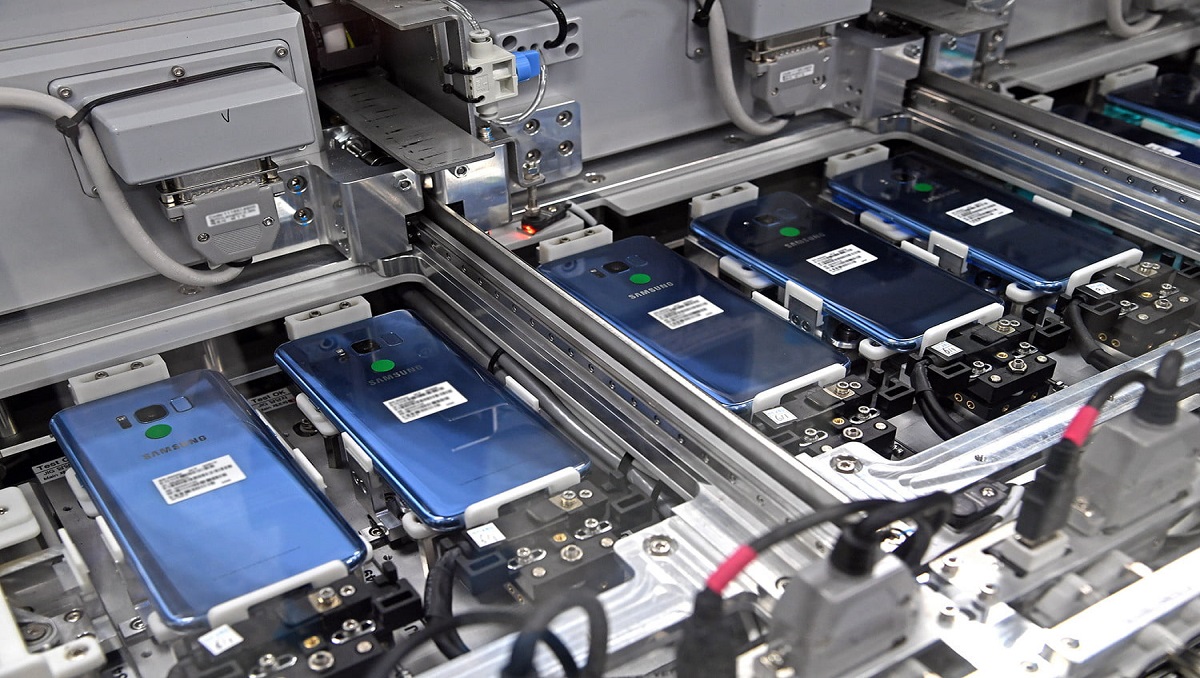From Global to Local- What Mobile Manufacturing Means for Pakistan

It’s an era of mobile phone and telecom technologies. With its ever-increasing demand, the mobile phone has already become a basic need for almost every person. Especially, after the COVID-19 pandemic, when the lockdown was imposed and the most convenient way to connect with others or perform our daily tasks was through the mobile phones, the demand for this gadget and related applications reached its maximum level. During the pandemic, the overall data usage also increased which in return, helped the telecom companies to gather more revenue hence contributing to the positive growth of the IT and telecom sector.
Pakistan itself has seen tremendous growth in the IT and telecom sectors over the past few years. No doubt, the inception of 3G/4G services in Pakistan has opened new avenues of growth and innovation in the country. With 191 million cellular subscribers, teledensity has reached 86.71% whereas, 3G/4G penetration stands at 49.94%. . According to the Pakistan Bureau of Statistics (PBS), Pakistan’s mobile imports witnessed an increase of 7.63 per cent in the first eight months from (July-February) the current fiscal year by reaching the value of $1311.493 million to $1,411.619 million.
So far, the establishment of local manufacturing plants has brought an investment of over $126 million to the country
To boost the telecom sector, the Government approved the local mobile phone manufacturing policy back in 2020. Pakistan Telecommunication Authority (PTA) in light of the policy issued Mobile Device Manufacturing (MDM) Regulations on January 28, 2021.
PTA has issued MDM authorization to 30 companies enabling them to manufacture mobile devices in Pakistan. The establishment of these manufacturing plants has brought an investment of over $126 million.
The Mobile Device Manufacturing Policy set a 49 per cent localization target by June 2023, including 10 per cent localization of parts of the motherboard and 10 per cent localization of batteries. As soon as the companies started manufacturing the mobile devices in the country, the mobile phone manufacturing industry saw significant growth in revenues and an affirmative decline in imports.
With a more than 200 million population and the ever-increasing sustainable demand for technology, Pakistan has become a very promising market for the IT and Telecom industry
According to the data revealed by PTA, Pakistan produced 24.66 million handsets in 2021. It is up from 13.05 million in the calendar year 2020, representing an 88 per cent increase. Moreover, the 4G assembled smartphones reached 10.06 million in 2021.
However, commercial imports reached 10.26 million in 2021. However, the local manufacturing plants have manufactured/assembled 1.53 million mobile phones including 0.86 million 2G and 0.67 million smartphones in January 2022.
The increase in local manufacturing has resulted in a decline in the imports of mobile phones. According to PBS, the imports of mobile phones decreased by 21.45 per cent in February 2022 as compared to the previous month of January.
As a result of the Mobile Phone Manufacturing Policy, which contains duty incentives for enhancing mobile phone assembling in Pakistan, the majority of phones cheaper than $200, are now assembled in Pakistan.
To achieve this milestone, various Chinese mobile phone manufacturers have played a key role. According to PTA, till November 2021, Itel topped the list by producing 3.91 million mobile devices followed by VGO Tel at 2.97 million, Infinix at 2.65 million Vivo at 2.45 million, Tecno at 1.87 million, QQMEE at 0.86 million, and Oppo 0.67 million. But these are not the only ones.
From Global to Local- What Mobile Manufacturing Means for Pakistan
Samsung has also officially started manufacturing smartphones in Pakistan. The company is hoping to manufacture around 3million devices per year in the country. Similarly, 2.5 to 3 million sets of Xiaomi would be produced per year in Pakistan in collaboration with Airlink Communication.
The import of manufactured or Completely Built Units (CBU) is on the decline while that of mobile phone components (CKD) is on the rise. From July-November 2021, the import of CBU decreased by 73% to USD$ 179 million as compared to USD 661 million during the same period last year. This saved USD$ 410 million in foreign exchange. In contrast, the import of mobile phone components for local assembly increased by 407% to USD$ 674 million from USD 133 million last year.
The successful implementation of the Device Identification Registration and Blocking System (DIRBS) along with conducive government policies including the mobile manufacturing policy has created a favourable environment for mobile device manufacturing in Pakistan. It has also contributed positively to the mobile ecosystem of Pakistan by eliminating the counterfeit device market while providing a level playing field for commercial entities and has created trust amongst consumers due to the formulation of standardized legal channels for all sorts of device imports.
Local mobile phone manufacturing has not only helped the telecom sector by increasing its revenue growth. But it also helped the country in many different ways. For instance, the local manufacturing industry had created almost 50,000 jobs already. Samsung aims to use labour-power for the manufacturing of mobile phones instead of machines which in return will produce millions of jobs for unemployed people of the country. It is also estimated that by increasing localization, production, and exports around 200,000 to half-million jobs in the country would have been created.
The successful implementation of (DIRBS) along with conducive government policies including the mobile manufacturing policy has created a favourable environment for mobile device manufacturing in Pakistan
According to PTA, only 53% of the population of the country is using smartphones. The remaining 47% population is still using 2G devices. This also indicates that Pakistan is still lagging behind in the 5G race. As per GSMA, this number is still low and by 2025, 74% of the population of Pakistan will be able to use smartphones. One of the main reasons for this is the high mobile prices. The lower class does not have the capacity to buy expensive or even midrange phones. The local mobile manufacturing will definitely lower the mobile prices and the availability of cheaper phones will increase which in return, will increase the smartphone penetration in the country. If the mobile manufacturing industry keeps on going at this pace, in the near future, internet penetration
will also increase. Hence, the whole digitalization process will speed up.
What more needs to be done?
Although, the mobile phone manufacturing industry is playing a good job of aggregating revenue growth. But there are still many ways to boost this growth. According to PBS, during the first five months of the fiscal year 2021-22, Pakistan earned $1051.050 million by offering various information technology IT services exports to other countries. Whereas, in August 2021, Pakistan has exported 5,500 units of 4G smartphones carrying the “manufactured in Pakistan” tag to the United Arab Emirates (UAE). Although it was a big achievement for the country, the number of exported devices is still very low. If the companies managed to increase this number, the revenue growth will also increase.
The government has plans to export the locally assembled phones to the markets like Africa, Central Asian Republics, and Afghanistan. It is a good initiative because Pakistan is currently manufacturing low-end mobile phones and it will be appropriate to export the phones to those countries that are preferably using the low-end phones.
Despite local manufacturing of mobile phones, the import bill is rising. The reason behind this is the import of high-end phones priced above $1000, a market segment that is not being manufactured in Pakistan currently. . The PBS data says that mobile phones worth $1.41 billion were imported during the first eight months (July-February) of the current fiscal year as compared to $1.31 billion during the same period of last year, registering a growth of 7.63 per cent. So, if the country starts producing high-end smartphones, the import bill will decline.
The government has plans to export the locally assembled phones to the markets like Africa, Central Asian Republics, and Afghanistan
The current government has proposed the Finance bill 2021-22 recently which indicates a great tax hike. In the new bill, the government has restored the 17 per cent sales tax on computer and IT equipment imports. Mobile phones worth more than $200 that are imported in CBU condition are also subject to a 17 per cent sales tax.
Although this increase in taxation is uncalled for it creates an opportunity for local manufacturers as high taxation discourages imports
Although this increase in taxation is uncalled for it creates an opportunity for local manufacturers as high taxation discourages imports. Therefore, when the devices are manufactured locally, there will be no tax and the prices of the phones will automatically drop and people will prefer locally manufactured phones instead of imported ones.
The lack of a component ecosystem is also a hurdle in the way of boosting the manufacturing industry in the country. Many electronic and non-electronic components are required to make a smartphone. Each phone needs component parts and many of the manufacturers of these parts already have deals with other brands. It is currently difficult to manufacture the phone from scratch. The assemblers are importing mobiles in semi-knocked down (SKD) condition, which are then assembled in Pakistan.
It’s not only the local production of cellphones but also a host of opportunities that it brings. From employment to investment and from export opportunities to local capacity building, it carries immense potential. If the growth rate keeps on increasing at this pace, in no time, Pakistan will be considered one of the leading smartphone manufacturing hubs just like China and India. This will attract foreign investment, save foreign exchange on mobile phone imports, earn foreign exchange via exports and create job opportunities for local people.
Check Also: Mobile Phones Taxes in Pakistan Calculator: PTA Mobile Taxes (2022)
PTA Taxes Portal
Find PTA Taxes on All Phones on a Single Page using the PhoneWorld PTA Taxes Portal
Explore NowFollow us on Google News!





